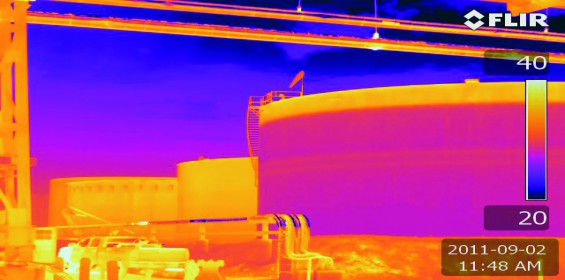No vessel is too small for thermal imaging inspection
Published: 26 February, 2019
An application at Cambridge Beer Festival demonstrates that no vessel is too small for thermal imaging inspection. Andrew Baker, sales director North Europe, FLIR Systems, reports.
The falling cost of the technology has now made it a cost-effective way to check the liquid level in a real ale beer cask and the temperature of its contents. This is just an entry-level example of how thermal imaging is being used but in industry at large it is also proving a quick and easy way of monitoring the integrity and content level of storage tanks. And there are now several IR technologies that can be used according to the requirement.
In the same way as a basic, pocket-sized thermal camera can be used to check a beer cask, it is also suitable in the industrial world for checking the content level of small tanks and drums. But, the same rule of thumb applies to this application as to any other, the greater amount of detail is provided as the resolution of the detector increases. As ever, pixel size matters as the target becomes larger or the application more complex.
To establish the content level of large storage tanks and silos a camera with a minimum detector size of 320 x 240 is essential. Typically, these tanks are found outdoors and unlagged so they are highly thermally conductive. During the day, the vessel and its contents absorb heat but at night they respectively lose temperature at different rates. And it’s this difference in temperature that allows the camera to depict the content level. The same technique is used to inspect the drainage efficiency of roofs that are also subject to thermal cycling.
Infrared is also a highly cost and time-efficient way to monitor the integrity of the structure of the tank and provide valuable information about the condition of the pipe network that feeds it. For example, heat losses due to failing insulation will show up very clearly in the thermal image as will problems with process valves. As well as leak detection the camera can also be used to determine whether the valve is open or closed, even from a distance, and if a pipe is blocked.
This type of inspection can be conducted by most professional, uncooled long-wave thermal imaging cameras with a sufficiently high resolution to provide the image clarity for the size of target but there is also another infrared technology that is increasingly being used for tank storage monitoring. Intrinsically safe optical gas imaging comes into its own where tank and pipework leaks are potential environmental or health hazards.
These cameras typically allow the detection of dangerous gases such methane, sulphur hexafluoride and several hundred others accurately and safely. Large areas can be rapidly scanned and leaks pinpointed in real time.
The technology is ideal for monitoring plant that is difficult to reach with contact measurement tools and literally thousands of vessels and components can be scanned per shift without the need to interrupt the process. It reduces repair downtime, provides verification of the process and above all, it is exceptionally safe, allowing potentially dangerous leaks to be monitored from many metres away.
Unlike the professional thermal imaging cameras used for condition monitoring, these are cooled models but they only need a few moments for the detector to reach its required temperature. There’s no complicated setting up procedure or post-processing involved, the invisible fugitive gases are displayed as plumes of smoke on the camera screen so their source can be easily identified.
Thermal imaging cameras are now available in all shapes, sizes, types and levels of sophistication to suit the application.
For further information please visit: www.flir.com







